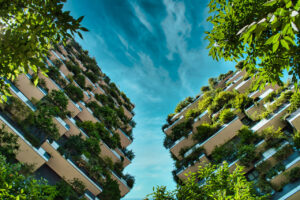
feature article
The Built Environment
The term ‘built environment’ is widely used but often is interpreted to represent structures such as homes and buildings. The ‘built environment’ includes all aspects of our everyday surroundings that have been constructed by humans, as distinct from the natural environment.
It not only includes buildings, but also all the infrastructure that supports our society such as roads, highways, bridges, and other components of our transportation systems, as well as our energy and water management systems, our communications networks, and so much more.

From a civil construction perspective, the built environment includes all forms of buildings such as housing, industrial and commercial facilities, hospitals, schools, and all their supporting civil engineering infrastructure, both above and below ground. It also includes the managed spaces between and around buildings.
Concrete is the main building product used to construct the built environment, and when viewed from this total perspective the enormity of the amount of concrete that supports our social and economic wellbeing is staggering.
While densely populated urban settings account for a more proportion of the concrete used in the built environment, in less populated rural settings a more remote, but large-scale physical infrastructure represent a sizeable component of the built environment. While on a global scale the share of human populations living in urban areas will increase, will increase, as our society expands into the less populated hinterland, concrete use in these areas will also rise.
A key issue arising from this fact is the diversity of responsibilities for the planning, development, construction, and operation of components of the built environment. Local municipal or township management. state or national authorities can prevail over different parts of the built environment and this can lead to considerable variability in the quality and upkeep of the physical plant. This highly decentralized infrastructure network creates challenges in terms of prioritizing investments on a national scale.

So too, efforts to lower the carbon footprint of the built environment often run afoul of diverse standards and best practices. And while basic engineering and design features play a significant role in the construction and upkeep of the built environment, fiscal constraints, and diverse public policy issues can be a major factor contributing to what is commonly referred to as the infrastructure deficit.
The American Society of Civil Engineers in its 2021 report estimates that the nation’s infrastructure faces an “infrastructure investment gap” of nearly $2.6 trillion this decade that, if unaddressed, could cost the United States $10 trillion in lost GDP by 2039.
Why this is significant is becoming increasingly apparent as a consequence of our changing climate, which is adding additional and often unprecedented stress to our physical infrastructure due to extreme weather events such as wildfires, torrential rains and flooding, and storm surges that overpower existing facilities ling considered capable of handling climate-related challenges.
Again, this is an area where concrete in its many forms will play an increasingly important roles in shaping the built environment of the future.
Build Back Better
Feature Article
Building Better and Resilient Buildings and Infrastructure in our communities to higher standards than are required by currently established building codes is critical to the future wellbeing of millions of people worldwide.

The Fundamentals of How Cement Is made
Feature Article
Cement is the basic ingredient of concrete. Concrete is formed when portland cement creates a paste with water that binds with sand and rock to harden.

Carbon Neutral Concrete
Feature Article
Concrete. It is the world’s most widely-used building material. It is estimated that the cement and concrete sectors account for roughly 5 to 7% of global carbon emissions.







